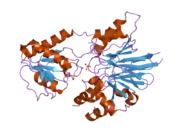| CPSF3 | |||||||||||||||||||||||||||||||||||||||||||||||||||
|---|---|---|---|---|---|---|---|---|---|---|---|---|---|---|---|---|---|---|---|---|---|---|---|---|---|---|---|---|---|---|---|---|---|---|---|---|---|---|---|---|---|---|---|---|---|---|---|---|---|---|---|
 | |||||||||||||||||||||||||||||||||||||||||||||||||||
| |||||||||||||||||||||||||||||||||||||||||||||||||||
| Identifiers | |||||||||||||||||||||||||||||||||||||||||||||||||||
| Aliases | CPSF3, CPSF-73, CPSF73, cleavage and polyadenylation specific factor 3 | ||||||||||||||||||||||||||||||||||||||||||||||||||
| External IDs | OMIM: 606029 MGI: 1859328 HomoloGene: 6499 GeneCards: CPSF3 | ||||||||||||||||||||||||||||||||||||||||||||||||||
| |||||||||||||||||||||||||||||||||||||||||||||||||||
| |||||||||||||||||||||||||||||||||||||||||||||||||||
| |||||||||||||||||||||||||||||||||||||||||||||||||||
| |||||||||||||||||||||||||||||||||||||||||||||||||||
| Wikidata | |||||||||||||||||||||||||||||||||||||||||||||||||||
| |||||||||||||||||||||||||||||||||||||||||||||||||||
Cleavage and polyadenylation specificity factor subunit 3 is a protein that in humans is encoded by the CPSF3 gene.[5][6]
References
- 1 2 3 GRCh38: Ensembl release 89: ENSG00000119203 - Ensembl, May 2017
- 1 2 3 GRCm38: Ensembl release 89: ENSMUSG00000054309 - Ensembl, May 2017
- ↑ "Human PubMed Reference:". National Center for Biotechnology Information, U.S. National Library of Medicine.
- ↑ "Mouse PubMed Reference:". National Center for Biotechnology Information, U.S. National Library of Medicine.
- ↑ Jenny A, Minvielle-Sebastia L, Preker PJ, Keller W (Dec 1996). "Sequence similarity between the 73-kilodalton protein of mammalian CPSF and a subunit of yeast polyadenylation factor I". Science. 274 (5292): 1514–7. Bibcode:1996Sci...274.1514J. doi:10.1126/science.274.5292.1514. PMID 8929409. S2CID 12958377.
- ↑ "Entrez Gene: CPSF3 cleavage and polyadenylation specific factor 3, 73kDa".
External links
- Human CPSF3 genome location and CPSF3 gene details page in the UCSC Genome Browser.
Further reading
- Murthy KG, Manley JL (1995). "The 160-kD subunit of human cleavage-polyadenylation specificity factor coordinates pre-mRNA 3'-end formation". Genes Dev. 9 (21): 2672–83. doi:10.1101/gad.9.21.2672. PMID 7590244.
- Jenny A, Hauri HP, Keller W (1994). "Characterization of cleavage and polyadenylation specificity factor and cloning of its 100-kilodalton subunit". Mol. Cell. Biol. 14 (12): 8183–90. doi:10.1128/MCB.14.12.8183. PMC 359357. PMID 7969155.
- Maruyama K, Sugano S (1994). "Oligo-capping: a simple method to replace the cap structure of eukaryotic mRNAs with oligoribonucleotides". Gene. 138 (1–2): 171–4. doi:10.1016/0378-1119(94)90802-8. PMID 8125298.
- Thuresson AC, Aström J, Aström A, et al. (1994). "Multiple forms of poly(A) polymerases in human cells". Proc. Natl. Acad. Sci. U.S.A. 91 (3): 979–83. Bibcode:1994PNAS...91..979T. doi:10.1073/pnas.91.3.979. PMC 521437. PMID 8302877.
- McCracken S, Fong N, Yankulov K, et al. (1997). "The C-terminal domain of RNA polymerase II couples mRNA processing to transcription". Nature. 385 (6614): 357–61. Bibcode:1997Natur.385..357M. doi:10.1038/385357a0. PMID 9002523. S2CID 4307073.
- Suzuki Y, Yoshitomo-Nakagawa K, Maruyama K, et al. (1997). "Construction and characterization of a full length-enriched and a 5'-end-enriched cDNA library". Gene. 200 (1–2): 149–56. doi:10.1016/S0378-1119(97)00411-3. PMID 9373149.
- Takagaki Y, Manley JL (2000). "Complex protein interactions within the human polyadenylation machinery identify a novel component". Mol. Cell. Biol. 20 (5): 1515–25. doi:10.1128/MCB.20.5.1515-1525.2000. PMC 85326. PMID 10669729.
- de Vries H, Rüegsegger U, Hübner W, et al. (2000). "Human pre-mRNA cleavage factor II(m) contains homologs of yeast proteins and bridges two other cleavage factors". EMBO J. 19 (21): 5895–904. doi:10.1093/emboj/19.21.5895. PMC 305781. PMID 11060040.
- Strausberg RL, Feingold EA, Grouse LH, et al. (2003). "Generation and initial analysis of more than 15,000 full-length human and mouse cDNA sequences". Proc. Natl. Acad. Sci. U.S.A. 99 (26): 16899–903. Bibcode:2002PNAS...9916899M. doi:10.1073/pnas.242603899. PMC 139241. PMID 12477932.
- Kaufmann I, Martin G, Friedlein A, et al. (2005). "Human Fip1 is a subunit of CPSF that binds to U-rich RNA elements and stimulates poly(A) polymerase". EMBO J. 23 (3): 616–26. doi:10.1038/sj.emboj.7600070. PMC 1271804. PMID 14749727.
- Calzado MA, Sancho R, Muñoz E (2004). "Human immunodeficiency virus type 1 Tat increases the expression of cleavage and polyadenylation specificity factor 73-kilodalton subunit modulating cellular and viral expression". J. Virol. 78 (13): 6846–54. doi:10.1128/JVI.78.13.6846-6854.2004. PMC 421638. PMID 15194760.
- Jin J, Smith FD, Stark C, et al. (2004). "Proteomic, functional, and domain-based analysis of in vivo 14-3-3 binding proteins involved in cytoskeletal regulation and cellular organization". Curr. Biol. 14 (16): 1436–50. doi:10.1016/j.cub.2004.07.051. PMID 15324660.
- Gerhard DS, Wagner L, Feingold EA, et al. (2004). "The status, quality, and expansion of the NIH full-length cDNA project: the Mammalian Gene Collection (MGC)". Genome Res. 14 (10B): 2121–7. doi:10.1101/gr.2596504. PMC 528928. PMID 15489334.
- Mandel CR, Kaneko S, Zhang H, et al. (2007). "Polyadenylation factor CPSF-73 is the pre-mRNA 3'-end-processing endonuclease". Nature. 444 (7121): 953–6. doi:10.1038/nature05363. PMC 3866582. PMID 17128255.
- de la Vega L, Sánchez-Duffhues G, Fresno M, et al. (2007). "The 73 kDa subunit of the CPSF complex binds to the HIV-1 LTR promoter and functions as a negative regulatory factor that is inhibited by the HIV-1 Tat protein". J. Mol. Biol. 372 (2): 317–30. doi:10.1016/j.jmb.2007.06.075. PMID 17669424.
This article is issued from Wikipedia. The text is licensed under Creative Commons - Attribution - Sharealike. Additional terms may apply for the media files.





